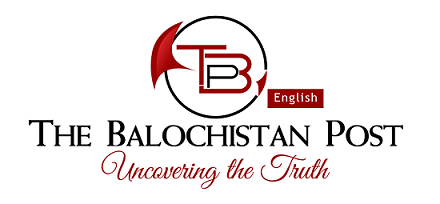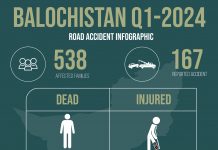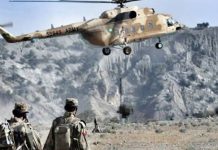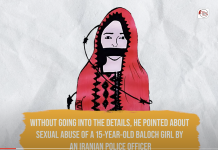Author: Dr Naseer Dashti
The historical journey of the Baloch is a tale of persecution, genocide, deportation, and struggle for survival. It is the story of a pastoralist nomadic people who not only survived against tremendous odds but also, as one of the unique examples in the history of Central Asia, became the master of a land where they initially entered as a group of migrating nomadic tribes. Their journey brought them into the present land of Balochistan, where they become culturally and linguistically dominant. They gave their name to the region and created a state of their own. After treading smoothly for a while, enjoying the dignity and honor in their newfound state, due to short-sightedness of their rulers and under the influence of strategic policies made in faraway lands, their journey into history ended with the occupation of their land and loss of their sovereignty.
It has been established that the Baloch belong to Indo-Iranic group of tribes. However, it is difficult to simply state that the people who presently call themselves Baloch belong to a homogenous racial entity. It would be justifiable to identify the Baloch as an admixture of original median branch of Aryan tribes with various invading nations and with the indigenous population of various places where the Baloch had been wandering in their long and tortuous journey. This is apparent from the diversity of the physical type of the Baloch, which strongly indicates that they had been mixed with other ethnic groups even before they began their migration from their original abode in the Caspian region toward east or before the beginning of their forced dispersion to eastern and southern corners of the Persian Empire. In ancient times, there had been an admixture of various people with Baloch like the Scythians, Parthians, Arsacid, Saka, Kushans, Huns, Turks, and many others. This fact also cannot be denied on any ground that the Baloch were greatly influenced by the languages and cultures of the indigenous population, which they came into contact at different stages of their walk from Balashagan to Balochistan. In the course of their en masse migrations, they have linguistic and cultural influences from Armenians, Kurds, Arabs, Turkmens, Persians, Dravidians, and other Indian groups. Indeed, a section of the Baloch tribes in present-day Balochistan speaks a language (Brahui), which is an admixture of Balochi, Turkish, and Dravidian languages. In present-day context, the Baloch identity can be defined as the feeling of a people of being “Baloch.”
The first phase of the Baloch history begins when a group of Indo-Iranic tribes of Central Asia, during the great migrations of Aryan tribes, settled in northwestern Iranian region of Balashakan (Balashagan) in ancient times. Here they were known as Balaschik. It is not clear whether they got their ethnic name by virtue of being the inhabitants of Balashagan or the land itself got its name from the people known as Balaschik. It appears that this group of pastoralist nomads had the firm belief in their way of life and could not tolerate any interference by outside forces neither on their traditional ways nor any encroachment on their territory. This behavior caused this people many miseries.
As part of wider Indo-Iranic group of tribes, the Balaschik were living as neighbors of other major or minor national entities of the ancient Central Asia like Medes, Persians, and the Parthians. They made strong linguistic and cultural connections with a Median group of tribes, which, later, became known as Kurds. Although they have been scantily mentioned in the historical accounts of that period, it appears that the Balashchik came into confrontation with major powers of the region while in Balashagan and sometimes, they became allies and part of the armies and fought for these powers.
Their head-on collisions with mighty Achaemenid and Sassanid rulers resulted in disasters for them. The history of their persecutions begins with vows of Achaemenid and Sassanid emperors to wipe out the Baloch from the face of earth. Although the persecutions, acts of genocide, and vows to annihilate the Baloch failed to materialize fully, the Baloch became a wandering nation and lost their territory and close ethnic allies. Circumstances forced this pastoralist nomadic group of tribes to migrate en masse and abandon their original homeland. After many centuries of wandering and sufferings, these pastoralist nomads ultimately settled in the south and eastern fringes of Iranian plateau.
The tortuous history of their long walk from Balashagan to present day Balochistan and from being Balashchik to becoming Baloch is a tale of miseries and wanderings. However, to survive physically against all odds and retaining their ethnic identity and keeping unity among various Baloch tribes at the times of tragedies and misfortunes is extraordinary and shows the resilience of this people.
Out of Balashagan and fleeing from persecutions, they scattered in different regions, including Sistan, Makuran, and Turan. It appears that at the time of the collapse of the Sassanid Empire, however, major concentration of the Baloch tribes was in Kerman.
With the fall of the Sassanid Empire and emergence of Arabs as the dominant power of the region in the seventh century begins a new chapter of the Baloch history. Starting from the alliance with Sia Sawar Baloch, the Baloch made their first contact with the advancing Arabs. At that time, they were mentioned as Koch o Baloch in the Arabic and Persian chronicles of that period. In the long drawn-out struggle for supremacy between the crumbling Persian Empire and the emerging Arabs, the Baloch failed to adopt a unified stance. Some of the Baloch, under the leadership of General Sia Sawar, sided with the Arabs, while the rest either adopted a neutral position or joined the Iranian resistance against the invading power. In the end, the Baloch faced persecution, humiliation, and deportations in various regions by the new rulers of Iran.
The persecution of the Baloch by conquering Arabs is one of the ugly episodes of the Baloch history. From the deportations and acts of genocides during the Arab supremacy the Baloch became very weak, materially and militarily. However, among them developed an increased sense of solidarity and national pride, which became fundamental in the formation of a national consciousness during the dark days of wanderings and migrations in medieval times.
The medieval period was a period of major upheavals in and around the Iranian plateau. The history of the Baloch in the medieval times is marked by bloody conflicts with various regional dynasties of the region after the collapse of Arab power in Iran. The Baloch, tribes who had been scattered in different regions of southeastern fringes of Iranian plateau, came into direct conflicts with Saffarids, Ghaznavids, Buyids, Seljuqs, and Mongols. It was the Buyids and Seljuqs who were responsible for major acts of genocide and mass deportation and migration of the Baloch from Kerman and Sistan.
It is interesting to note that the acts of barbarism against the Baloch were justified by the powers of the day on the ground that the Baloch had been continually harassing the settled population of the region. However, the fact is that these “harassments” were rather a reaction from the Baloch against encroachments on their traditional way of living a life independent of any state or organized authority.
The Baloch history of medieval times is also marked by painful migrations, struggle for survival, development of formal tribal structures, formation of tribal unions, and settling of a section of the Baloch in permanent settlements. Although, for obvious reasons, the Baloch tribal confederacies could not play a major political role in the power-plays of the region at that time, nevertheless, it was the dominating cultural and linguistic influences of these unions which later formed the basis of the Baloch national identity. With the dominance of the Baloch culture and language, the whole area became recognized as Balochistan (the land of the Baloch).
One of the important happenings in the Baloch history of that period was the en masse migration of a group of the Baloch tribes from Barez Mountain of Kerman into Turan via Sistan. The union of these tribes who later became known as Barezui or Brahui into a confederacy paved the way for the establishment of the first Baloch state. The development of Brahui language (which is an admixture of Balochi dialect spoken around Bashkard region with elements of Turkish and Dravidian languages) is also a remarkable happening of medieval period in a Baloch perspective.
History of the Baloch people during medieval times is a history of fundamental social transformation in which individual tribal identities gave way to larger tribal groupings. There also occurred fundamental changes in the social organization of the tribes. During this period of constant uncertainty and conflicts, the Baloch tribes began to organize in strict hierarchical patterns, which are still being manifested in the social organization of many tribes in contemporary Balochistan.
Among the important developments during medieval times was the establishment of core cultural values in the Baloch society. Sociocultural values, which govern the conventions on various rights and responsibilities of a Baloch, were firmly established during the twelfth and sixteenth centuries. It was the particular context of constant vigilance against uncertain situations and assimilation of other ethnic and tribal entities into the Baloch national identity that became responsible for a stubborn behavior and a secular mindset among the Baloch.
The phenomenon of the Baloch national identity began to take shape. In an unprecedented but remarkable development, the wandering and nomadic Baloch tribes began to assimilate vast segments of other ethnic groups. The history of the Baloch in this period is also marked with the adaption of a settled way of life and involvement in the agricultural activities. Taking firm roots of a secular mindset was established during this period, which is one of the fundamental Baloch social behaviors and is the result of intermingling and assimilation of various ethnic groups with diverse religious beliefs.
Now it has been established beyond any doubt that the Balochi language belongs to the northwestern group of Iranian languages related to Middle Persian and Parthian languages and having close affinities with Median languages like Kurdish, Tati, and Taleshi. With the absorption of various influences from the languages spoken in the areas where the Baloch came into contact during their migrations, the Balochi language took its present shape and became the lingua franca of the region where they finally settled. In the consolidation of the Baloch cultural values and development of a Baloch national consciousness, it played a fundamental role.
The political turmoil of the seventeenth century in India and Persia became very important for the Baloch. The whole area was witnessing dramatic changes because of the intense power struggle between the dying empires of the Mughals and Safavid and the European powers, which were increasingly encroaching on various regions of India and Persian Gulf. In the prevailing state of anarchy, various regional ethnic groups began to assert themselves. Following the example of Abdalis and Gilzais of Harat and Kandahar, various Baloch confederacies also joined the race. The first Baloch state emerged from the fog of chaotic state of the affairs in the region.
The establishment of the first Baloch chiefdom in Turan, which later transformed into the Baloch state of Kalat, was a turning point in the history of the Baloch. The migratory pastoralist nomads finally became the master of a region, having their own ruler or Khan. Their state incorporated the cherished Baloch social and tribal values into its unwritten constitution and remained on the map of the world for about 300 years. The Khanate of Kalat was the first Baloch state to embrace all Baloch regions in western and eastern Balochistan and consolidate them into a body under the authority of a central government.
With the establishment of the Khanate, there occurred fundamental changes in the economy and society of the nomadic Baloch tribes. Acquisition of agricultural lands of Kachchi offered a relatively firm economic base for the impoverished masses in Turan. With the enthusiastic support of the tribes of Sarawan and Jhalawan, the Khanate was able to expand its authority into a vast area. The Baloch became familiarized with the ways of settled life, and a period of economic wellbeing and nation-formation began.
The history of the Baloch state is a story of ups and downs. It is marked with expansions westward and eastward. It is also marked with the struggle of the Baloch state to retain a sovereign status vis-à-vis emerging powers of Persia and Afghanistan. The history of the Baloch state is also marked with continued struggle of power between various contenders among the Ahmadzai ruling clan. After the initial phase of unity between tribal chiefs and the Khan, there was a continued tussle between the Khan of the Baloch and tribal chiefs.
The immediate successors of Mir Ahmad were unable to sustain the gains made in political, administrative, or financial aspects of the state. The chiefs of tribes and the Khans were vying for safeguarding their traditional powers in the framework of the Khanate. Sardars were operating with considerable independence, often breaching the solidarity of the Khanate by appealing to authorities at Sindh and Kandahar for support in factional disputes among themselves and with the Khan. To counter the influence of Sardars, Mir Mahabat Khan nearly surrendered the sovereignty of the Baloch state to Afghan Kingdom.
The Baloch state reached its peak under the leadership of Mir Naseer Khan I. His reign, which lasted for almost fifty years, was the golden age of the Khanate of Kalat. During the latter half of the eighteenth century, Kalat attained its maximum territorial expansion, conquering western parts of Makuran and various regions of Sistan, including Nemroz. He introduced land reforms and held the law and order in full control, boasting economic activities in the state. After Mir Naseer Khan I, continued civil war, struggle for the throne of the Khanate among the various members of Ahmadzai clan, intrigues of court officials, and loss of important territories to Punjab, Afghanistan, and Sindh were events that caused the prestige, power, and finances of the Khanate at a very low ebb.
The occupation of Balochistan by the British in 1839 was a watershed in the history of the Baloch. The Khan of the Baloch was killed, and the Khanate came under the rule of the British East India Company. Under different treaties, Balochistan lost its sovereignty and the British-ruled Balochistan through puppet Khans. The Baloch resistance against the occupying forces was disorganized and failed to have an impact. As tribal chiefs led the resistance, the colonial power skillfully manipulated them in order to divide the Baloch resistance. However, failing to get a firm grip on Balochistan through Khan and Sardars, the British took over the direct control of Balochistan by signing a treaty in 1876. Introduction of administrative reforms by the British administration changed the basic fabrics of the Baloch society, and it helped the British to crush successfully the pockets of Baloch resistance against their rule.
The phase of the Baloch history, which begins by the British occupation of Kalat, witnessed increased Persian incursion upon western Balochistan and the ultimate division of Balochistan under various boundary commissions. This division gave a major portion of Balochistan to Persia and a small territory to Afghanistan. The British policy of appeasement toward Persia, their obsession of establishing Afghanistan as a viable buffer state between Russia and British India, and the protection of Indo-European Telegraph Line were the immediate causative factors in the division of Balochistan.
The Baloch resistance against Persian domination in western Balochistan finally collapsed with the fall of the Baloch chiefdom of the Barakzai Dynasty. After gaining full control of western Balochistan, the Persians took drastic measures to erode the foundation of the Baloch national identity and cultural traditions. They embarked upon a systematic and well-planned program of total assimilation of the Baloch into an artificial Persian national identity.
The phase of the Baloch history, which began in the twentieth century, had far-reaching consequences for the Baloch as an independent national entity. After the collapse of the Baloch resistance against occupation, beginning from the first quarter of the twentieth century, the political mobilization of the Baloch against the colonial domination continued under the leadership of a group of the Baloch youth. They began to mobilize the Baloch masses by forming the Anjuman-e-Itehad-e-Baloch-wa-Balochistan. The Anjuman became Kalat State National Party, which was the first political party in the history of the Baloch. It became the guiding force in the struggle. to regain the sovereignty of the Baloch state in the wake of British withdrawal from India in 1947.
The creation of the religious state of Pakistan in 1947 was among the happenings of the history, which ultimately caused the demise of the Baloch state of Kalat. Before quitting, the British divided India by creating a state on religious grounds, joining various Muslim majority regions. During the process of division and independence of India and withdrawal of the British, the Baloch witnessed a shortlived independence of their country. However, they also witnessed the tragic occupation of Balochistan Pakistan.
Many factors were responsible for the collapse of the Baloch state. Balochistan was without a robust leadership, the international situation was not favorable for the Baloch, and creating and sustaining a viable Pakistan to serve its regional interest was the top priority of the colonial power. With the occupation of Balochistan by Pakistan on April 1, 1948, the Baloch dreams of regaining their sovereignty after a long period of colonial occupation were shattered, and a state of overall frustration and humiliation prevailed upon the Baloch horizons.
The long walk from Balashagan to present-day Balochistan and from being Balashchik to Baloch was tortuous and painful. However, to survive physically against all odds and retaining their ethnic identity and keeping unity among various Baloch tribes at the times of tragedies and misfortunes, is extraordinary. It is an interesting aspect of the history how an ethnic group, consisting of pastoralist nomads from the hardship of centuries of wandering through Iranian plateau, not only survived physically but successfully struggled to preserve their national and linguistic identity, and within a few centuries, they were able to establish a nation-state in the regions where they settled after their long wanderings.
The historical journey of the Baloch is still not ended. Their struggle to regain their lost sovereignty is continuing. The contemporary history of the Baloch is marked with tales of heroism from the Baloch resistance fighters and violent events causing human tragedies, human right violations, and acts of genocide on the part of the powers controlling the Baloch and Balochistan.
This text was excerpted from Dr Naseer Dashti’s renowned book “The Baloch and Balochistan.” This insightful work delves into the rich history, culture, and socio-political dynamics of the Baloch people and their homeland, Balochistan. For those interested in exploring this subject further, the book is available for purchase on Amazon & Kindle.






























